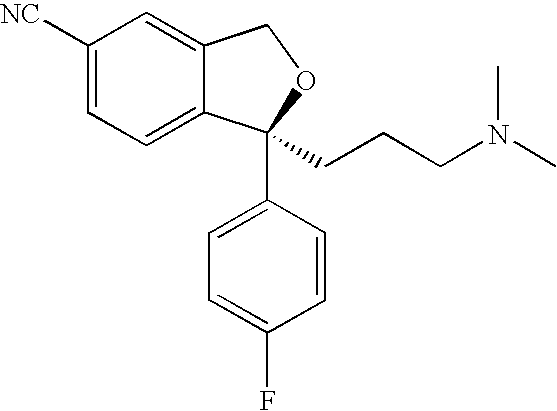Method for manufacture of escitalopram
a technology of escitalopram and manufacture method, which is applied in the field of manufacture of escitalopram, can solve the problems of time and solvent consumption, low purity of enantiomeric products, and inability to manufacture escitalopram, and achieves the effects of good draining properties, good filtering properties, and robust and stable methods
- Summary
- Abstract
- Description
- Claims
- Application Information
AI Technical Summary
Benefits of technology
Problems solved by technology
Method used
Image
Examples
experiment 1
[0045](+)-O,O′-Di-p-toluoyl-(S,S)-tartaric acid (0.39 eq) was dissolved in 1-propanol (3.44 V). The mixture was heated up to ca. 40° C. and acetic acid (0.2 eq.) was added. This solution was transferred within one hour to a solution of 4-[4-(dimethylamino)-1-(4′-fluorophenyl)-1-hydroxybutyl]-3-(hydroxymethyl)-benzonitrile free base in 1-propanol (0.95 V) containing 0.1 V of toluene. The resolution mixture, containing now in total 4.4 V 1-propanol was seeded with seed crystals comprising S-4-[4-(dimethylamino)-1-(4′-fluorophenyl)-1-hydroxybutyl]-3-(hydroxymethyl)-benzonitrile and (+)-O,O′-di-p-toluoyl-(S,S)-tartaric acid and then stirred at 40° C. for 2 hours. The mixture was cooled to 20-25° C. within 2 hours. The product was filtered and washed twice with 1-propanol. The enantiomeric purity was typically in the range from about 91% to about 98% S.
[0046]The product was re-slurried in 1-propanol (2.5 V) at around 50° C. for 2 hours. The mixture was cooled to 20-25° C. The product was...
experiment 2
[0048](+)-O,O′-Di-p-toluoyl-(S,S)-tartaric acid (0.4 eq) was dissolved in 1-propanol (3.5 V). The mixture was heated up to ca. 40° C., acetic acid (0.2 eq.) was added and then the solution is transferred to a solution of 4-[4-(dimethylamino)-1-(4′-fluorophenyl)-1-hydroxybutyl]-3-(hydroxymethyl)-benzonitrile free base in 1-propanol containing 0.1 V toluene. The resolution mixture, containing now in total 4.5 V 1-propanol was seeded with seed crystals comprising S-4-[4-(dimethylamino)-1-(4′-fluorophenyl)-1-hydroxybutyl]-3-(hydroxymethyl)-benzonitrile and (+)—O,O′-di-p-toluoyl-(S,S)-tartaric acid and then stirred at 40° C. for two hours. The mixture was cooled to 20-25° C. in two hours. The product was filtered (filter reactor) and washed with 1-propanol.
[0049]The enantiomeric purity was typically around 97% S or higher.
[0050]An exemplary batch gave molar yield: 33.8%, enantiomeric purity: 99.0% S.
experiment 3
[0051]The general procedure of Experiment 2 was applied, however 0.5 eq of (+)-O,O′-di-p-toluoyl-(S,S)-tartaric acid and 10V of 1-propanol were used. No toluene or acetic acid was present in the system.
[0052]An exemplary batch gave molar yield: 29.5%; enantiomeric purity: 99.2% S.
PUM
| Property | Measurement | Unit |
|---|---|---|
| temperature | aaaaa | aaaaa |
| temperature | aaaaa | aaaaa |
| v/v | aaaaa | aaaaa |
Abstract
Description
Claims
Application Information
 Login to View More
Login to View More - R&D
- Intellectual Property
- Life Sciences
- Materials
- Tech Scout
- Unparalleled Data Quality
- Higher Quality Content
- 60% Fewer Hallucinations
Browse by: Latest US Patents, China's latest patents, Technical Efficacy Thesaurus, Application Domain, Technology Topic, Popular Technical Reports.
© 2025 PatSnap. All rights reserved.Legal|Privacy policy|Modern Slavery Act Transparency Statement|Sitemap|About US| Contact US: help@patsnap.com

